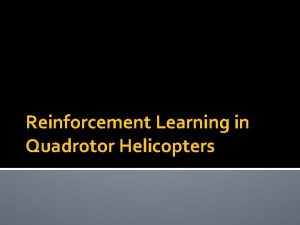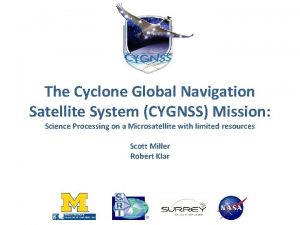ECE ILLINOIS Navigation System on a Quadrotor Andrew

- Slides: 1

ECE ILLINOIS Navigation System on a Quadrotor Andrew Douglas, Pei Liu Mentor: David Hanley Data Gathered Motivation Many different applications of robotics requires that a robot be able to understand its position relative to its origin as well as have a map of its surroundings. Our work has been focused on improving Visual Inertial Odometry (VIO) and Inertial Navigation System for use in robots to monitor construction sites. Research Plan • Improve the testing standards for VIO research in order to have more significant experiments The main improvement in testing involves achieving better time synchronization between the robot and the computer collecting data Incorporate data from wind sensor into the system to enhance usability in real world implementation Investigate the impact reconfiguring the structure of IMU has on performance of IMU • • • Current Progress • Different time synchronization protocols have been investigated (Network Time Protocol and Precision Time Protocol) A turbulent environment was created in the lab by an industrial fan to simulate the real world environment A wind map was made to display wind speed at different locations in the room • • Results • Background • Applications of Robotics that Depend on VIO • • Construction site monitoring – robots need to adapt to complex and dynamic environments GPS will achieve an accuracy of 1 -5 meter Robots must have an accurate sense of their position indoors such as a shopping mall or construction site Robot also use inertial navigation system that calculates position, orientation and velocity via dead reckoning Time synchronization was achieved between the computer and robot at levels of approximately 2 milliseconds The wind map shown above was generated to model the wind conditions that can be generated in the lab Future Directions • • Measure direction of the wind by putting wind vanes at different positions of the room. Finish setting up Dragonboard and make it collect data Investigate other time-synchronization platforms to see if better performance can be achieved Find additional ways to increase the accuracy within the experiments Acknowledgements • We would like to thank David Hanley for his patient and consistent mentorship. We would also like to thank PURE committee members for taking their time and creating this great opportunity that connects us with graduate mentors.

